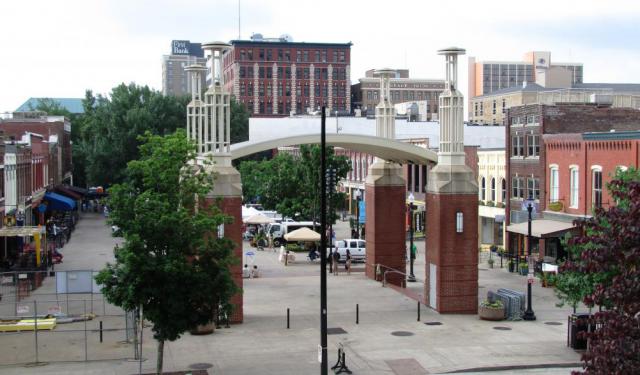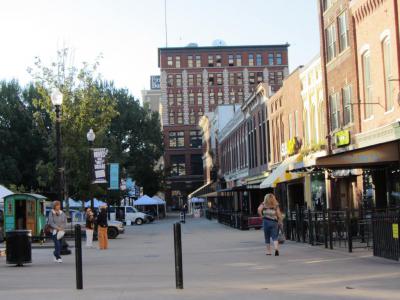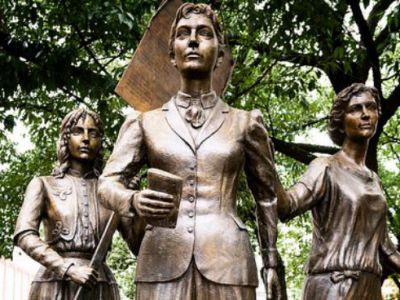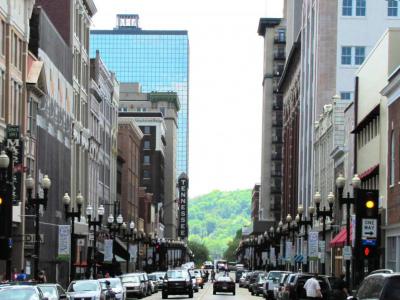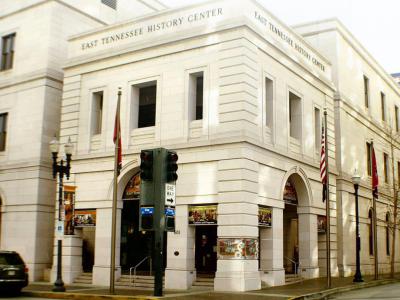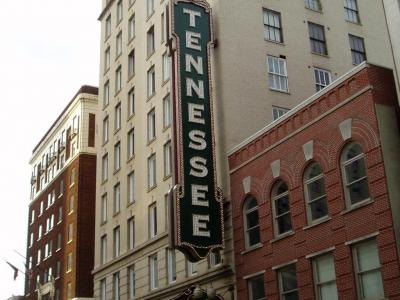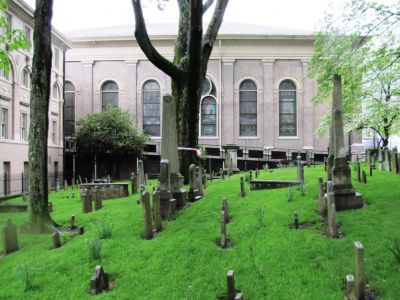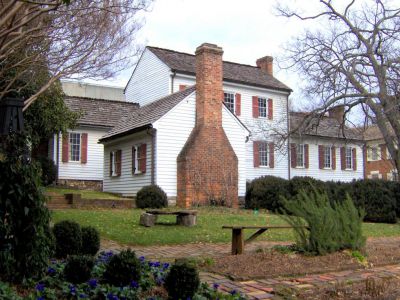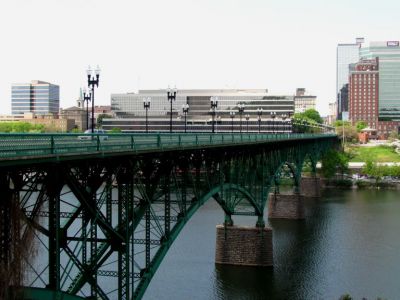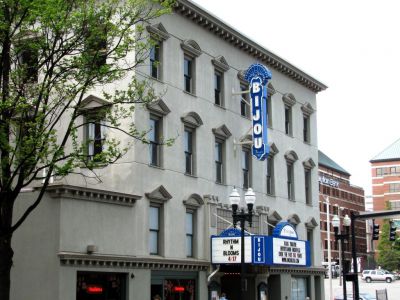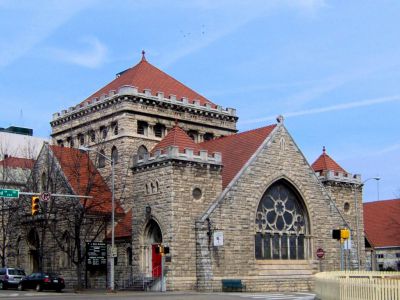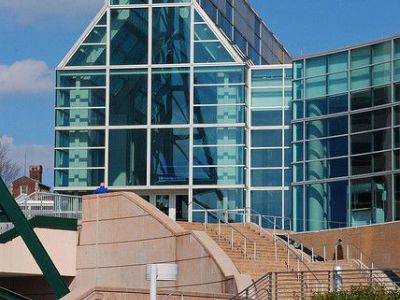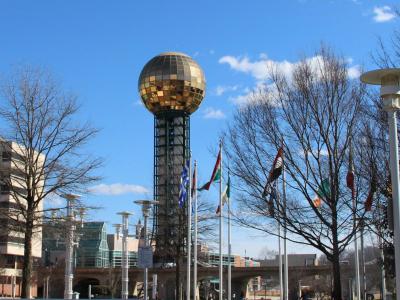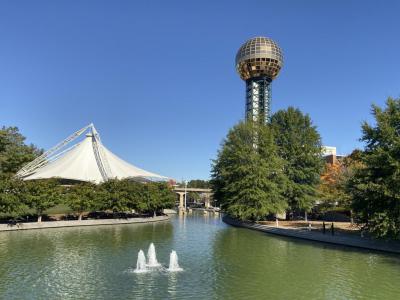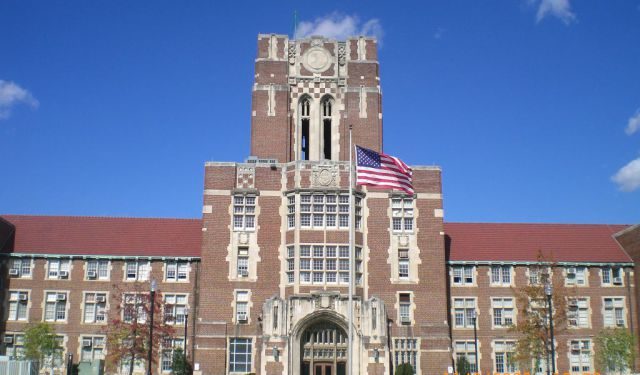Downtown Knoxville Walking Tour (Self Guided), Knoxville
A small town with big-city amenities and a vibrant music scene (a mix of country, bluegrass, and rock), Knoxville, or K-Town as it's popularly shortened by locals, is also often referred to as “the Gateway to the Great Smoky Mountains,” for its proximity to the national park area, whose marble quarries, in the past, gave it another moniker, The Marble City.
Knoxville was founded in 1791 by James White, a Revolutionary War veteran, and named after Henry Knox, the first United States Secretary of War. From 1796 to 1817, it served as the first capital of the state of Tennessee.
Throughout the early 19th century, the city struggled with geographic isolation until the arrival of the railroad, in 1855, which led to an economic boom. At that time, the premier local gathering spot, Market Square, was built.
Knoxville played a significant role in the American Civil War for its strategic location between the northern and southern states. It was occupied alternately by Confederate and Union armies, culminating in the Battle of Fort Sanders in 1863, following which the city remained firmly under the Union forces' control.
After the war, Knoxville enjoyed rapid growth, becoming a center for the textile and marble industries. In the 1920s, as the manufacturing sector collapsed, the city's economy stagnated and the downtown district declined. Still, the arrival of movies during that period prompted the construction of one of the city's most popular cultural landmarks, the Tennessee Theatre.
Nearly half a century later, some New York newspaper wondered, “What if you gave a World's Fair and nobody came?”, suggesting it was a likely scenario for a "scruffy little city" on the Tennessee River (referring to Knoxville's rough-around-the-edges, DIY vibe). To this, Knoxville responded in style by holding a boffo exposition and celebrating success with a slogan declaring: "The Scruffy Little City Did It." And this is how its yet another nickname came to be.
Indeed, hosting the 1982 World's Fair helped reinvigorate Knoxville, especially its downtown. The purpose-built 70-acre World's Fair Park today features a new city symbol, the iconic SunSphere tower.
Down South, they say, people “don't hide their crazy but parade it down the street.” To see if that can be attributed to Knoxville's unique personality, take this self-guided walk and find out!
Knoxville was founded in 1791 by James White, a Revolutionary War veteran, and named after Henry Knox, the first United States Secretary of War. From 1796 to 1817, it served as the first capital of the state of Tennessee.
Throughout the early 19th century, the city struggled with geographic isolation until the arrival of the railroad, in 1855, which led to an economic boom. At that time, the premier local gathering spot, Market Square, was built.
Knoxville played a significant role in the American Civil War for its strategic location between the northern and southern states. It was occupied alternately by Confederate and Union armies, culminating in the Battle of Fort Sanders in 1863, following which the city remained firmly under the Union forces' control.
After the war, Knoxville enjoyed rapid growth, becoming a center for the textile and marble industries. In the 1920s, as the manufacturing sector collapsed, the city's economy stagnated and the downtown district declined. Still, the arrival of movies during that period prompted the construction of one of the city's most popular cultural landmarks, the Tennessee Theatre.
Nearly half a century later, some New York newspaper wondered, “What if you gave a World's Fair and nobody came?”, suggesting it was a likely scenario for a "scruffy little city" on the Tennessee River (referring to Knoxville's rough-around-the-edges, DIY vibe). To this, Knoxville responded in style by holding a boffo exposition and celebrating success with a slogan declaring: "The Scruffy Little City Did It." And this is how its yet another nickname came to be.
Indeed, hosting the 1982 World's Fair helped reinvigorate Knoxville, especially its downtown. The purpose-built 70-acre World's Fair Park today features a new city symbol, the iconic SunSphere tower.
Down South, they say, people “don't hide their crazy but parade it down the street.” To see if that can be attributed to Knoxville's unique personality, take this self-guided walk and find out!
How it works: Download the app "GPSmyCity: Walks in 1K+ Cities" from Apple App Store or Google Play Store to your mobile phone or tablet. The app turns your mobile device into a personal tour guide and its built-in GPS navigation functions guide you from one tour stop to next. The app works offline, so no data plan is needed when traveling abroad.
Downtown Knoxville Walking Tour Map
Guide Name: Downtown Knoxville Walking Tour
Guide Location: USA » Knoxville (See other walking tours in Knoxville)
Guide Type: Self-guided Walking Tour (Sightseeing)
# of Attractions: 13
Tour Duration: 2 Hour(s)
Travel Distance: 2.3 Km or 1.4 Miles
Author: Sandra
Sight(s) Featured in This Guide:
Guide Location: USA » Knoxville (See other walking tours in Knoxville)
Guide Type: Self-guided Walking Tour (Sightseeing)
# of Attractions: 13
Tour Duration: 2 Hour(s)
Travel Distance: 2.3 Km or 1.4 Miles
Author: Sandra
Sight(s) Featured in This Guide:
- Market Square
- Tennessee Women's Suffrage Memorial
- Gay Street
- East Tennessee History Center
- Tennessee Theatre, Burwell Building
- First Presbyterian Church and Its Cemetery
- William Blount Mansion
- Gay Street Bridge
- Bijou Theatre
- St. John's Cathedral
- Knoxville Convention Center
- Knoxville SunSphere
- World's Fair Park
1) Market Square (must see)
A local newspaper once dubbed Market Square in Knoxville "the most democratic place on earth" where "the rich and the poor, the white and the black, jostle each other in perfect equality."
The square was built in 1854 as a market venue for regional farmers; the bell from the old Market House, found on the Union Avenue side of the square, serves as a reminder of those days. From 1868 to 1924, the place was home to Knoxville's City Hall.
Over the years, Market Square has witnessed many different events, from concerts to political rallies, and been a popular gathering spot for artists, street performers, veterans, and activists of various sorts. Attesting to this is the Women's Suffrage Memorial which commemorates Tennessee's role in achieving Women's suffrage in the United States.
In the 20th century, if you're a country music fan, Market Square was also the place to come and listen to gospel singers and fiddlers playing on the corner. A small store in the northeastern part of Market Square was a notable destination on the country music map. Here, opened by Sam Morrison, was a record shop that used to spin hits before they made it on the radio.
The most notable artist ever promoted by Morrison was Elvis Presley. The legend has it that he played Presley’s “That’s All Right, Mama” on the store's loudspeakers right out into the square. That record sold hundreds of copies, including two to an RCA talent scout who came in search of a country music star. And that's how the King was born!
Currently, Market Square is a year-round venue for special outdoor events, such as a seasonal farmer's market, the "Sundown in the City" concert series, and community band concerts. During the winter, it also plays host to an open-air ice skating rink.
In 1984, the square was listed on the National Register of Historic Places.
The square was built in 1854 as a market venue for regional farmers; the bell from the old Market House, found on the Union Avenue side of the square, serves as a reminder of those days. From 1868 to 1924, the place was home to Knoxville's City Hall.
Over the years, Market Square has witnessed many different events, from concerts to political rallies, and been a popular gathering spot for artists, street performers, veterans, and activists of various sorts. Attesting to this is the Women's Suffrage Memorial which commemorates Tennessee's role in achieving Women's suffrage in the United States.
In the 20th century, if you're a country music fan, Market Square was also the place to come and listen to gospel singers and fiddlers playing on the corner. A small store in the northeastern part of Market Square was a notable destination on the country music map. Here, opened by Sam Morrison, was a record shop that used to spin hits before they made it on the radio.
The most notable artist ever promoted by Morrison was Elvis Presley. The legend has it that he played Presley’s “That’s All Right, Mama” on the store's loudspeakers right out into the square. That record sold hundreds of copies, including two to an RCA talent scout who came in search of a country music star. And that's how the King was born!
Currently, Market Square is a year-round venue for special outdoor events, such as a seasonal farmer's market, the "Sundown in the City" concert series, and community band concerts. During the winter, it also plays host to an open-air ice skating rink.
In 1984, the square was listed on the National Register of Historic Places.
2) Tennessee Women's Suffrage Memorial
The life-size bronze sculpture of three women in downtown Knoxville's Market Square honors female campaigners for the state of Tennessee to ratify the 19th Amendment to the United States Constitution to grant women the right to vote. Tennessee was the final state to ratify the amendment and have it added to the Constitution, and thus was the focus of considerable effort both from local women and those traveling from other states to assist them. The ratification vote was passed on August 18, 1920.
The memorial, created by Nashville artist Alan LeQuire, depicts leaders of the suffrage movement, namely: Elizabeth Avery Meriwether of Memphis, Lizzie Crozier French of Knoxville, and Anne Dallas Dudley of Nashville. Funded with private donations, it was commissioned by the Suffrage Coalition and unveiled on 26 August, 2006 as part of a day of commemorations, which included a re-enactment of a suffrage march, with women in vintage clothes and replica sashes, carrying replica banners.
The base of the sculpture features text on the campaign and a number of quotations from the campaigners, including the following by Harriot Eaton Stanton Blatch:
"All honor to women, the first disenfranchised class in history who unaided by any political party, won enfranchisement by its own effort alone, and achieved the victory without the shedding of a drop of human blood."
The memorial, created by Nashville artist Alan LeQuire, depicts leaders of the suffrage movement, namely: Elizabeth Avery Meriwether of Memphis, Lizzie Crozier French of Knoxville, and Anne Dallas Dudley of Nashville. Funded with private donations, it was commissioned by the Suffrage Coalition and unveiled on 26 August, 2006 as part of a day of commemorations, which included a re-enactment of a suffrage march, with women in vintage clothes and replica sashes, carrying replica banners.
The base of the sculpture features text on the campaign and a number of quotations from the campaigners, including the following by Harriot Eaton Stanton Blatch:
"All honor to women, the first disenfranchised class in history who unaided by any political party, won enfranchisement by its own effort alone, and achieved the victory without the shedding of a drop of human blood."
3) Gay Street
Gay Street traverses the heart of Knoxville's downtown area. Since its development in the 1790s, the street has served as the city's principal financial and commercial thoroughfare, playing a primary role in its historical and cultural evolution. Part of Charles McClung's original 1791 plat of Knoxville, Gay Street was a focal point for the early political activity of both the city and the State of Tennessee.
By 1850, Gay Street had accommodated three-fourths of Knoxville's commercial activity and in 1854 became the first paved road in the city. On the eve of the Civil War, Gay Street was the site of simultaneous Union and Confederate recruiting rallies. After the war, it saw extensive commercial development as railroad construction brought an industrial boom to Knoxville.
Today, Gay Street is home to the largest office buildings and oldest commercial structures in Knoxville; several local buildings are listed on the National Register of Historic Places.
By 1850, Gay Street had accommodated three-fourths of Knoxville's commercial activity and in 1854 became the first paved road in the city. On the eve of the Civil War, Gay Street was the site of simultaneous Union and Confederate recruiting rallies. After the war, it saw extensive commercial development as railroad construction brought an industrial boom to Knoxville.
Today, Gay Street is home to the largest office buildings and oldest commercial structures in Knoxville; several local buildings are listed on the National Register of Historic Places.
4) East Tennessee History Center (must see)
The East Tennessee History Center (ETHC) is housed in a landmark building that has been a federal facility for over 100 years. Constructed in 1874, this was the first federal building in the city and was designed by prominent architect, James Knox Taylor, featuring a mix of Italianate, Renaissance Revival, and Second Empire styles.
Among other things, in the late 19th century, this building made history as a popular hangout of “Fiddlin’ Bob” Robert L. Taylor, a pension agent who used to entertain visitors with his tall tales, jokes, and, most importantly, his masterly fiddle playing. A talented performer, he regularly took part in fiddling competitions in Market Square and did so well, in fact, that his fiddling skills saw him become one of Tennessee’s most prominent politicians. Using fiddle as a political tool (performing at political rallies), Taylor eventually succeeded at becoming a state governor, from 1887 to 1891 and again from 1897 to 1899, and then a U.S. Senator. So much for fiddling, huh...
Originally, the building served as a customs house and post office, until 1934, following which it was repurposed as a courthouse. After being vacated in the 1980s, it was renovated and converted for use as a museum and research center, while retaining many of its original features and historical character.
An expansion completed in 2004 beautifully complements the original structure and provides access to all of ETHC’s resources. Today, the building accommodates the Historical Society, Historical Museum, the Calvin M. McClung Historical Collection, and the Knoxville County Archives. You will also find the genealogy department of the Knoxville County Public Library here.
Among other things, in the late 19th century, this building made history as a popular hangout of “Fiddlin’ Bob” Robert L. Taylor, a pension agent who used to entertain visitors with his tall tales, jokes, and, most importantly, his masterly fiddle playing. A talented performer, he regularly took part in fiddling competitions in Market Square and did so well, in fact, that his fiddling skills saw him become one of Tennessee’s most prominent politicians. Using fiddle as a political tool (performing at political rallies), Taylor eventually succeeded at becoming a state governor, from 1887 to 1891 and again from 1897 to 1899, and then a U.S. Senator. So much for fiddling, huh...
Originally, the building served as a customs house and post office, until 1934, following which it was repurposed as a courthouse. After being vacated in the 1980s, it was renovated and converted for use as a museum and research center, while retaining many of its original features and historical character.
An expansion completed in 2004 beautifully complements the original structure and provides access to all of ETHC’s resources. Today, the building accommodates the Historical Society, Historical Museum, the Calvin M. McClung Historical Collection, and the Knoxville County Archives. You will also find the genealogy department of the Knoxville County Public Library here.
5) Tennessee Theatre, Burwell Building (must see)
The Tennessee Theatre is a 1920s-era movie palace, located within the Burwell Building in downtown Knoxville. It occupies an annex added to the building in 1928, while the building itself was constructed in 1907. At a height of 166 feet (51 m), it remained Knoxville's tallest structure until 1912.
The theater first opened on October 1, 1928, and with nearly 2,000 seats in the auditorium, was billed as "Knoxville's Grand Entertainment Palace". Its interior was designed by Chicago architects Graven & Mayger in the Spanish-Moorish style, while also incorporating elements from different parts of the world, such as French-style chandeliers with Czechoslovakian crystals, Italian terrazzo flooring in the Grand Lobby, and Oriental influences in the carpet and drapery patterns. It also featured a beautiful Wurlitzer Organ. The theater was one of the first public buildings in Knoxville to have air conditioning.
Even though it was originally built as a “motion picture palace,” the Tennessee Theatre regularly played host to live music and weekend talent shows that gave stars of country music a chance to perform on its historic stage. Among them, Roy Acuff, dubbed the "King of Country Music", had his first public appearance here during a talent show. He admitted to having never won the first place, though, since the competition was too stiff.
Famous musicians across genres still grace the theater's stage to this day, making it one of the most significant standing country music landmarks in East Tennessee. In 1982, the theater was placed on the National Register of Historic Places.
The theater first opened on October 1, 1928, and with nearly 2,000 seats in the auditorium, was billed as "Knoxville's Grand Entertainment Palace". Its interior was designed by Chicago architects Graven & Mayger in the Spanish-Moorish style, while also incorporating elements from different parts of the world, such as French-style chandeliers with Czechoslovakian crystals, Italian terrazzo flooring in the Grand Lobby, and Oriental influences in the carpet and drapery patterns. It also featured a beautiful Wurlitzer Organ. The theater was one of the first public buildings in Knoxville to have air conditioning.
Even though it was originally built as a “motion picture palace,” the Tennessee Theatre regularly played host to live music and weekend talent shows that gave stars of country music a chance to perform on its historic stage. Among them, Roy Acuff, dubbed the "King of Country Music", had his first public appearance here during a talent show. He admitted to having never won the first place, though, since the competition was too stiff.
Famous musicians across genres still grace the theater's stage to this day, making it one of the most significant standing country music landmarks in East Tennessee. In 1982, the theater was placed on the National Register of Historic Places.
6) First Presbyterian Church and Its Cemetery
The First Presbyterian Church Graveyard is the oldest in Knoxville. It was established in the 1790s and holds the remains of some of the city's most notable early residents, including Governor William Blount and Knoxville's founder James White. The graveyard was officially recognized as a historic site in 1996 and is listed in the National Register of Historic Places.
James White reserved a lot for the cemetery when he was planning Knoxville in 1791, and the earliest burial marker, belonging to Blount, dates back to 1800.
The First Presbyterian Church was built near the cemetery in 1816. The graveyard was used for burials for almost 60 years and was most active during the Epidemic of 1838 when hundreds of people died from an unknown disease. The last burial took place in 1879, and the graveyard was used by Confederate and Union soldiers during the Civil War.
The present First Presbyterian Church was built in 1903 and is a Neoclassical building. The graveyard has a typical Anglo-American design with closely placed headstones and simple inscriptions. A low iron fence surrounds the perimeter, and crude stone walkways provide access.
James White reserved a lot for the cemetery when he was planning Knoxville in 1791, and the earliest burial marker, belonging to Blount, dates back to 1800.
The First Presbyterian Church was built near the cemetery in 1816. The graveyard was used for burials for almost 60 years and was most active during the Epidemic of 1838 when hundreds of people died from an unknown disease. The last burial took place in 1879, and the graveyard was used by Confederate and Union soldiers during the Civil War.
The present First Presbyterian Church was built in 1903 and is a Neoclassical building. The graveyard has a typical Anglo-American design with closely placed headstones and simple inscriptions. A low iron fence surrounds the perimeter, and crude stone walkways provide access.
7) William Blount Mansion
The Blount Mansion, also known as William Blount Mansion, is the former home of William Blount (1749–1800), the only territorial governor of the Southwest Territory (the Territory South of the Ohio River, created in 1790). Originally a North Carolina businessman and land speculator, Blount was appointed governor by President George Washington. A signer of the United States Constitution, he was also instrumental in the inauguration of Tennessee as the 16th state and later served as a U.S. Senator from Tennessee.
Blount lived on this property together with his family and 10 African-American slaves. Much of the Tennessee Constitution was drafted in Governor Blount's office at the mansion, from 1792 to 1796. Tennessee state historian John Trotwood Moore once called Blount Mansion "the most important historical spot in Tennessee."
Blount's reasons for building an elaborate frame house on the frontier were twofold. First, it would act as a de facto capitol of the Southwest Territory, and thus would need to command the respect of visiting delegations. Second, Blount wanted to fulfill a promise he made to his wife, Mary Grainger Blount, to build a home comparable to their lavish North Carolina home.
Constructed between 1792 and 1830, the graceful two-story house with a single bedroom upstairs is a wood-frame, hall-parlor home sheathed in wood siding, built with materials brought from North Carolina in an era when most homes in Tennessee were log cabins.
By 1925, the house had deteriorated and was on a brink of demolition. Fortunately, the purpose-established Blount Mansion Association, following a massive publicity campaign, managed to raise enough money to purchase the house in 1930. Committed to its preservation and a positive comprehension of national, regional and local history, the Association has since maintained the property as a museum and made numerous renovations to restore it to its late 18th-century appearance. In the 1960s, the mansion was designated a National Historic Landmark and in 1966 included in the National Register of Historic Places.
Blount lived on this property together with his family and 10 African-American slaves. Much of the Tennessee Constitution was drafted in Governor Blount's office at the mansion, from 1792 to 1796. Tennessee state historian John Trotwood Moore once called Blount Mansion "the most important historical spot in Tennessee."
Blount's reasons for building an elaborate frame house on the frontier were twofold. First, it would act as a de facto capitol of the Southwest Territory, and thus would need to command the respect of visiting delegations. Second, Blount wanted to fulfill a promise he made to his wife, Mary Grainger Blount, to build a home comparable to their lavish North Carolina home.
Constructed between 1792 and 1830, the graceful two-story house with a single bedroom upstairs is a wood-frame, hall-parlor home sheathed in wood siding, built with materials brought from North Carolina in an era when most homes in Tennessee were log cabins.
By 1925, the house had deteriorated and was on a brink of demolition. Fortunately, the purpose-established Blount Mansion Association, following a massive publicity campaign, managed to raise enough money to purchase the house in 1930. Committed to its preservation and a positive comprehension of national, regional and local history, the Association has since maintained the property as a museum and made numerous renovations to restore it to its late 18th-century appearance. In the 1960s, the mansion was designated a National Historic Landmark and in 1966 included in the National Register of Historic Places.
8) Gay Street Bridge
A 1,512-foot (461 m) structure crossing the Tennessee River, linking downtown Knoxville to its southern part, the Gay Street Bridge is an impressive element of the city skyline. Completed in 1898, this is the oldest of four vehicle bridges in Knoxville. Its temporary pontoon prototype was built at this site during the American Civil War, around 1860.
A number of permanent bridges that appeared here later on suffered ill fate. The first one, supported by stone piers, built by Union General Ambrose E. Burnside, was washed away in a flood in March 1867. A replacement covered bridge, built by Knox County and opened on May 2, 1875, was blown down by a tornado shortly afterward. The county then sold the surviving piers and rights-of-way to G. W. Saulpaw, who built a wooden Howe truss bridge here in 1880. That bridge stood until 1898, when it was demolished upon the completion of the Gay Street Bridge.
The present arched, steel spandrel-braced (cantilevered) bridge features a concrete deck, and was designed by Charles E. Fowler. The latter boasted that he had hastily sketched the bridge's design-which was chosen over three other bids-on the back of an envelope during his train ride to Knoxville to meet with county officials. Construction of the bridge began in 1897. Due to the scarcity of construction materials during the Spanish–American War, Fowler was forced to modify his original design, and was constantly bickering with Knox County officials over who should pay the extra costs. Curiously, at the time, Knox County issued a statement proclaiming the bridge "for the use of all the world except Spain," in reference to the war which had been raging throughout the year.
The Gay Street Bridge opened to traffic on July 9, 1898. Originally, its deck contained trolley tracks and thus accelerated residential development in the Island Home Park area on the south side of the river, which had previously been isolated from downtown Knoxville. These tracks, however, were removed in 1950. Today, the deck consists of two vehicle lanes, each flanked by a pedestrian sidewalk.
Engineering journals, such as Engineering News and Bridge Engineering, have praised Gay Street Bridge for its combination of safety and aesthetics.
A number of permanent bridges that appeared here later on suffered ill fate. The first one, supported by stone piers, built by Union General Ambrose E. Burnside, was washed away in a flood in March 1867. A replacement covered bridge, built by Knox County and opened on May 2, 1875, was blown down by a tornado shortly afterward. The county then sold the surviving piers and rights-of-way to G. W. Saulpaw, who built a wooden Howe truss bridge here in 1880. That bridge stood until 1898, when it was demolished upon the completion of the Gay Street Bridge.
The present arched, steel spandrel-braced (cantilevered) bridge features a concrete deck, and was designed by Charles E. Fowler. The latter boasted that he had hastily sketched the bridge's design-which was chosen over three other bids-on the back of an envelope during his train ride to Knoxville to meet with county officials. Construction of the bridge began in 1897. Due to the scarcity of construction materials during the Spanish–American War, Fowler was forced to modify his original design, and was constantly bickering with Knox County officials over who should pay the extra costs. Curiously, at the time, Knox County issued a statement proclaiming the bridge "for the use of all the world except Spain," in reference to the war which had been raging throughout the year.
The Gay Street Bridge opened to traffic on July 9, 1898. Originally, its deck contained trolley tracks and thus accelerated residential development in the Island Home Park area on the south side of the river, which had previously been isolated from downtown Knoxville. These tracks, however, were removed in 1950. Today, the deck consists of two vehicle lanes, each flanked by a pedestrian sidewalk.
Engineering journals, such as Engineering News and Bridge Engineering, have praised Gay Street Bridge for its combination of safety and aesthetics.
9) Bijou Theatre
The Bijou Theatre is housed in the Lamar House Hotel building and is located in the rear wing thereof which was added in 1909.
The hotel itself dates back to 1817 and was modified in the 1850s. It was built by Irish immigrant Thomas Humes (1767–1816) and his descendants and quickly emerged as a gathering place for Knoxville's wealthy. During the Civil War, the Union Army used the building as a hospital for their wounded. Following the war, the hotel became the center of Knoxville's Gilded Age extravagance, hosting lavish masquerade balls for the local elite.
In 1909, it had a new lobby cut through from Gay Street to accommodate the Bijou Theatre which opened its doors for the first time on March 8, 1909. In the following decades, at various times, the theater served as a venue for traditional stage performances, vaudeville, and a second-run and pornographic movie house, as well as a commencement stage for the city's African-American high school.
Among those who have graced the theater's stage over the years are the likes of the Marx Brothers, Dizzy Gillespie, John Philip Sousa, the Ballets Russes, Ethel Barrymore, Alfred Lunt and Lynn Fontanne, John Cullum, and Houdini.
In recognition of their architectural and historical value, both the building and the theater were added to the National Register of Historic Places in 1975.
The hotel itself dates back to 1817 and was modified in the 1850s. It was built by Irish immigrant Thomas Humes (1767–1816) and his descendants and quickly emerged as a gathering place for Knoxville's wealthy. During the Civil War, the Union Army used the building as a hospital for their wounded. Following the war, the hotel became the center of Knoxville's Gilded Age extravagance, hosting lavish masquerade balls for the local elite.
In 1909, it had a new lobby cut through from Gay Street to accommodate the Bijou Theatre which opened its doors for the first time on March 8, 1909. In the following decades, at various times, the theater served as a venue for traditional stage performances, vaudeville, and a second-run and pornographic movie house, as well as a commencement stage for the city's African-American high school.
Among those who have graced the theater's stage over the years are the likes of the Marx Brothers, Dizzy Gillespie, John Philip Sousa, the Ballets Russes, Ethel Barrymore, Alfred Lunt and Lynn Fontanne, John Cullum, and Houdini.
In recognition of their architectural and historical value, both the building and the theater were added to the National Register of Historic Places in 1975.
10) St. John's Cathedral
Saint John's Church was established in 1826, 35 years after Knoxville was founded. It was one of the congregations represented at the Primary Convention during the organization of the Diocese of Tennessee in Nashville in 1829. In May 1844, with 25 communicants, Saint John’s became the first mission from Eastern Tennessee to be admitted to the Diocese of Tennessee.
The original building was demolished in 1891 to create space for a larger facility, which was designed by J.W. Yost of Columbus, Ohio and completed in 1892. The stone church has a Latin cross form, but the nave, transepts, and apse are relatively small compared to the crossing, resulting in a spacious central area. The architectural style is Richardsonian Romanesque and features a slate roof, turrets, buttresses, and rose windows.
A fire in 1919 destroyed many of the original stained glass windows, but the church was promptly restored. In 1963, extensive renovation was carried out to create an undercroft under the nave floor. In 1986, Saint John’s was designated as the seat of the bishop for the newly created Diocese of East Tennessee.
The church office is adjacent to Saint John's Episcopal Cathedral. It is a two-story, classical brick building erected in 1857 by O. F. Hill to serve as both home and office. The original porch had Tuscan columns and extended the full width of the house, but it was eventually removed. The present porch is more modest. The house faces the James Park House across Cumberland Avenue to the south.
The original building was demolished in 1891 to create space for a larger facility, which was designed by J.W. Yost of Columbus, Ohio and completed in 1892. The stone church has a Latin cross form, but the nave, transepts, and apse are relatively small compared to the crossing, resulting in a spacious central area. The architectural style is Richardsonian Romanesque and features a slate roof, turrets, buttresses, and rose windows.
A fire in 1919 destroyed many of the original stained glass windows, but the church was promptly restored. In 1963, extensive renovation was carried out to create an undercroft under the nave floor. In 1986, Saint John’s was designated as the seat of the bishop for the newly created Diocese of East Tennessee.
The church office is adjacent to Saint John's Episcopal Cathedral. It is a two-story, classical brick building erected in 1857 by O. F. Hill to serve as both home and office. The original porch had Tuscan columns and extended the full width of the house, but it was eventually removed. The present porch is more modest. The house faces the James Park House across Cumberland Avenue to the south.
11) Knoxville Convention Center
The Knoxville Convention Center is a large, modern venue located on the former site of the US Pavilion of the 1982 World's Fair. The state-of-the-art facility was built in 2002 to a design inspired by a Tennessee barn.
Among its amenities, the center features half a million square feet of space on three floors and an underground loading dock. Its exhibition hall contains more than 120,000 square feet (11,000 m2) of flexible space, as well as a 27,300-square-foot ballroom, a lecture hall, and fourteen meeting rooms. Overall, the place is fit to accommodate up to 10,000 people at a time and is sufficient to host a variety of events like trade shows, conventions, meetings, concerts, and sporting games.
In addition to its event spaces, the Knoxville Convention Center also offers a variety of services to event planners and attendees, including catering, audiovisual services, and free Wi-Fi throughout the facility.
Among its amenities, the center features half a million square feet of space on three floors and an underground loading dock. Its exhibition hall contains more than 120,000 square feet (11,000 m2) of flexible space, as well as a 27,300-square-foot ballroom, a lecture hall, and fourteen meeting rooms. Overall, the place is fit to accommodate up to 10,000 people at a time and is sufficient to host a variety of events like trade shows, conventions, meetings, concerts, and sporting games.
In addition to its event spaces, the Knoxville Convention Center also offers a variety of services to event planners and attendees, including catering, audiovisual services, and free Wi-Fi throughout the facility.
12) Knoxville SunSphere (must see)
Sometimes jokingly referred to as "The Lord's Golf Tee", the Sunsphere is an 81.07 m (266 ft) high hexagonal steel truss structure, topped with a 23 m (75 ft) gold-colored glass sphere.
Designed by the Knoxville-based architectural firm Community Tectonics, this is one of only two remnants from the 1982 World's Fair in Knoxville still standing; the other one is the Tennessee Amphitheater, located directly across a man-made pond.
In line with the Sun theme, the window glass panels of the structure are layered with 24-karat gold dust. It weighs 600 tons and features six double steel truss columns to support the seven-story sphere. The sphere itself, in its original design, had a diameter of 86.5 feet (26.4 m) to represent symbolically the 865,000-mile (1,392,000 km) diameter of the Sun. During the Fair, the tower served as a restaurant which had on its menu such items as the Sunburger and a rum-and-fruit juice cocktail, called the Sunburst.
Throughout much of the 1980s and into the early 1990s, the building stood vacant. In 2007, the Sunsphere began to see occupancy.
In February 2022, the Sunsphere observation deck was reopened. Capable of holding up to 90 people, it offers a breathtaking 360-degree view stretching from downtown to the Great Smoky Mountains including World’s Fair Park, the Tennessee River, and the University of Tennessee Campus. Other on-site amenities include a 1982 World’s Fair timeline, a gallery, memorabilia, and a gift shop.
Originally created as the symbol of the Fair, today the Sunsphere serves as a symbol for Knoxville, often featured on postcards and logos.
Admission is $5 per person and free for children under 12.
Designed by the Knoxville-based architectural firm Community Tectonics, this is one of only two remnants from the 1982 World's Fair in Knoxville still standing; the other one is the Tennessee Amphitheater, located directly across a man-made pond.
In line with the Sun theme, the window glass panels of the structure are layered with 24-karat gold dust. It weighs 600 tons and features six double steel truss columns to support the seven-story sphere. The sphere itself, in its original design, had a diameter of 86.5 feet (26.4 m) to represent symbolically the 865,000-mile (1,392,000 km) diameter of the Sun. During the Fair, the tower served as a restaurant which had on its menu such items as the Sunburger and a rum-and-fruit juice cocktail, called the Sunburst.
Throughout much of the 1980s and into the early 1990s, the building stood vacant. In 2007, the Sunsphere began to see occupancy.
In February 2022, the Sunsphere observation deck was reopened. Capable of holding up to 90 people, it offers a breathtaking 360-degree view stretching from downtown to the Great Smoky Mountains including World’s Fair Park, the Tennessee River, and the University of Tennessee Campus. Other on-site amenities include a 1982 World’s Fair timeline, a gallery, memorabilia, and a gift shop.
Originally created as the symbol of the Fair, today the Sunsphere serves as a symbol for Knoxville, often featured on postcards and logos.
Admission is $5 per person and free for children under 12.
13) World's Fair Park (must see)
World's Fair Park is a public space in downtown Knoxville, located on the former grounds of the 1982 World's Fair. Prior to the event, the site was used as a railroad yard and was converted into a park specially for the fair.
After it was closed, in October 1982, the site was cleaned up, pavilions demolished, and throughout the rest of the 1980s and into the early 1990s, the place remained vacant.
The two last standing structures from the exposition, the Sunsphere and the Tennessee Amphitheater are now the park's key attractions. In 2018, the Knoxville City Council approved their $2.5-million renovation, updating the Sunsphere's elevators, replacing HVAC units, repairing windows, and repainting the exterior of both structures.
Apart from these two landmarks, the park features a 5-acre (2.0 ha) performance lawn, currently used for cultural and community events, and a small lake with a fountain.
Surrounding the area are the Knoxville Museum of Art, the Knoxville Convention Center, and the L&N STEM Academy (located at the former Louisville and Nashville station). To the west of the park is the building known as the Candy Factory, which once housed the South, Littlefield & Steere Company and its factory. During the fair, the Candy Factory building was used by the administration.
After it was closed, in October 1982, the site was cleaned up, pavilions demolished, and throughout the rest of the 1980s and into the early 1990s, the place remained vacant.
The two last standing structures from the exposition, the Sunsphere and the Tennessee Amphitheater are now the park's key attractions. In 2018, the Knoxville City Council approved their $2.5-million renovation, updating the Sunsphere's elevators, replacing HVAC units, repairing windows, and repainting the exterior of both structures.
Apart from these two landmarks, the park features a 5-acre (2.0 ha) performance lawn, currently used for cultural and community events, and a small lake with a fountain.
Surrounding the area are the Knoxville Museum of Art, the Knoxville Convention Center, and the L&N STEM Academy (located at the former Louisville and Nashville station). To the west of the park is the building known as the Candy Factory, which once housed the South, Littlefield & Steere Company and its factory. During the fair, the Candy Factory building was used by the administration.
Walking Tours in Knoxville, Tennessee
Create Your Own Walk in Knoxville
Creating your own self-guided walk in Knoxville is easy and fun. Choose the city attractions that you want to see and a walk route map will be created just for you. You can even set your hotel as the start point of the walk.
Knoxville’s Historical Buildings
Knoxville is often referred to as "The Marble City" for the abundant supply of high-quality marble used in many of its buildings. Noting the wealth of well-preserved historic homes in the city, prominent American architect John Russell Pope even coined his own moniker for it – the "City of Houses".
Indeed, Knoxville's eventful and sometimes turbulent past, dating from... view more
Tour Duration: 2 Hour(s)
Travel Distance: 2.2 Km or 1.4 Miles
Indeed, Knoxville's eventful and sometimes turbulent past, dating from... view more
Tour Duration: 2 Hour(s)
Travel Distance: 2.2 Km or 1.4 Miles
University of Tennessee Walking Tour
Founded in 1794 as William Blount College, The University of Tennessee (UT) in Knoxville is one of the oldest public universities in the United States. Nowadays, the UT flagship institution features a mix of historic and modern sites which draw many a visitor to the city.
The campus covers nearly 600 acres in downtown’s west end, including over 200 buildings and a faculty of more than 1,700... view more
Tour Duration: 2 Hour(s)
Travel Distance: 3.0 Km or 1.9 Miles
The campus covers nearly 600 acres in downtown’s west end, including over 200 buildings and a faculty of more than 1,700... view more
Tour Duration: 2 Hour(s)
Travel Distance: 3.0 Km or 1.9 Miles
The Most Popular Cities
/ view all
